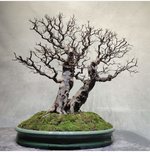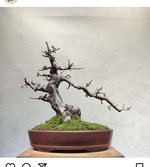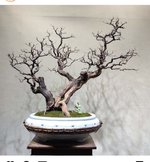bendem
Yamadori
"Morning wood" can be a problem.I heard stories about people having "relationships" with trees, but it sounded painful.
"Morning wood" can be a problem.I heard stories about people having "relationships" with trees, but it sounded painful.
A few more then, this time from my phone. I highly recommend following “hongkongbonsaipots” if you have an Instagram.Yes! This is partly what inspired me to start this thread. I'd love to see more of those trees





Just takes a very long time!
If its natural, it ain't ugly............There are lots of trees where the branches naturally radiate zig-zag, but also lots that branch at an ugly 90°
I might disagree with this. If I had learned the proper way to apply wire initially then my trees would definitely be better for it.People, wannabes, default to C&G because they are unfamiliar/unskilled with wire and do manage to shaped trees without it, but will never achieve on a higher plane until they get over doing without. I lead a workshop every year for beginners where we have at least 3 coaches that stay with 3 or 4 people the whole 3 hours and make sure they wire, style and repot a fig, and take home a ~finished~ tree that they wired with their own hands. Getting over that first hump is half the battle and they can buy some wire and play at home and get better over time. Having done it once, they can do it again.
Probably one of the most counter-productive messages to newbees is the insistence by some high-achievers that wire has to look nice and have the correct 45° angle and spacing blah, blah, blah. That scares the hell out of ordinary people and interferes with their self confidence, fearing negative public critiques by Big Shooters. You can imagine that I have some really bad names to call these so-called "teachers". My message is "Get Started now; get better later". The tree will look better because of what the wire does having little or nothing to do with how proper the wire has been applied.

No fair! He's in Florida and has year-around growing. For the rest of us rabble we have to suffer through 6 months of parking. He can probably cut off more than we can grow in a year.I might disagree with this. If I had learned the proper way to apply wire initially then my trees would definitely be better for it.
I can make a thousand excuses for still sloppy wiring but I won’t.
One of my initial introductions to bonsai was Jim Smith- I was amazed at his ficus. From my understanding there wasn’t a lot of wire used in his creations. I still love his work.
The Art of Bonsai Project - Feature Gallery: The Bonsai of Jim Smith
About The Art of Bonsai Project. An effort to explore the aesthetic and artistic elements of bonsai, including technical composition, presentation, display and other ways in which bonsai impacts the human eye and soul.artofbonsai.org
I have also seen twisted curvy trees that I don’t think could be produced with solely clip and grow.
View attachment 386898
That was a great little read. Has me looking at a few of my shohin elms in a whole different light. Thanks for sharing this @BobbyLaneOne of Potters elms that he's never used wire on:
View attachment 386000
"I am often asked what is my favourite bonsai. As always I can’t offer a straight answer. We move more than two thousand bonsai a year here and I love the day new trees arrive. I also love the day they leave because KB got paid. However I am not as mercenary as that, I have a collection of bonsai and raw material I have kept to myself now and some of those trees have been with me for nearly 25 years.
I do not have a favourite species of tree to work on. Tree species all have unique characteristics and many change throughout the year making them very interesting to work with at different times. So my favourite bonsai? A very good one that looks it’s best and has been developed to bring out it’s unique character. The other thing I love (being a Brit’) is an underdog. Most of my bonsai journey has been about making ugly trees into pretty ones. Some trees I see are beyond hope but others just need a caring hand and a skilled eye to reveal their inner beauty.
When you keep bonsai trees you have to come to terms with the fact that not everything can look it’s best all the time. Many folk believe it’s possible to have a collection of bonsai that look like pictures lifted from magazines, IT”S NOT. Bonsai need to be allowed to grow and as such most cannot be perfectly manicured all year around. However it should be possible to have a tree come to perfection at least once a year or perhaps every couple of years.
So my favourite bonsai tree changes throughout the year. Even with 3000 trees in the garden there are rarely more than two that are peaking at any one time. At this time of year I do have one very special bonsai that helps reinforce my conviction about what I am doing and, just for good measure the tree is a bit of an underdog too.
I bought this Chinese elm about 15 years ago from another bonsai nursery. It was a typical Chinese tree with balls of foliage on the end of each branch. However underneath I could see something very special. This elm lives outside all year around. I have to re-pot every year and about every 5 years it has to be cut back very hard into old wood and re-twigged. The bark is stunning now and the tree has never been wired. In February every year it drops it’s leaves and for about 3 weeks is stunning. This is, to me, the epitome of an old English woodland tree and today it IS my favourite bonsai." -G Potter
see blog post for more detailed images of this elm

My Favourite Bonsai ? - Graham Potter | Kaizen Bonsai Blog
I am often asked what is my favourite bonsai. As always I can’t offer a straight answer. We move more than two thousand bonsai a year here and I love the day new trees arrive. I also love the day they leave because KB got paid. However I am not as mercenary as that, I […]www.kaizenbonsai.com
It’s super easy to anneal on a barbecue grill. I’ve done a couple of batches on my gas grill of wire that I recycled by unwinding it from trees. The last time, I bought some 6 gauge from Home Depot and added it to the batch. Wiring a tree with it was just as easy as with annealed wire that I’ve purchased. I use 4 gauge as well, and no one is annealing that since Jim Gremel stopped selling wire, so I’ll be annealing my own. It may be hard to find gauges smaller than 12 without insulation, so I’ll probably keep buying those from Jeremiah McKinney at Adams Bonsai.Do most people anneal themselves or is it more common to just buy annealed?
Delightful.Going back to the harsh bends I mentioned, they definitely don’t suit every tree. This is all just my personal opinion/taste but I wouldn’t just clip and grow a juniper, maple or spruce. In my opinion some amount of wire is needed to elevate those species. The old photos of Chinese styled junipers don’t do it for me. But in the other hand elm, pine and most fast growing broadleaf trees will take on an amazing tortured tense appearance from chaotic angle changes. And now .. those photos I said I’d share a few days ago
When I talk about clip and grow I don’t just mean “directional pruning”. I’m talking about lingnan school aesthetics. Branches that move up and down, not just horizontal. As zhao calls them “elk antlers” and “crab legs”. Doing this is nearly impossible without having crossing branches in some places. Which my eye sees as a ton of depth in the tree, it is more chaotic than defined layers but trees in nature are chaotic. It always comes down to a matter of opinion, one style could never be deemed better than another of
This elm has soul in my opinion. Part of that comes from the lack of regimented form between structural branches yet overall harmony. Far more harmonious with what you actually see outside on either side of the pond. One could argue the top is more regimented, but it would occur on a normal healthyOne of Potters elms that he's never used wire on:
View attachment 386000
"I am often asked what is my favourite bonsai. As always I can’t offer a straight answer. We move more than two thousand bonsai a year here and I love the day new trees arrive. I also love the day they leave because KB got paid. However I am not as mercenary as that, I have a collection of bonsai and raw material I have kept to myself now and some of those trees have been with me for nearly 25 years.
I do not have a favourite species of tree to work on. Tree species all have unique characteristics and many change throughout the year making them very interesting to work with at different times. So my favourite bonsai? A very good one that looks it’s best and has been developed to bring out it’s unique character. The other thing I love (being a Brit’) is an underdog. Most of my bonsai journey has been about making ugly trees into pretty ones. Some trees I see are beyond hope but others just need a caring hand and a skilled eye to reveal their inner beauty.
When you keep bonsai trees you have to come to terms with the fact that not everything can look it’s best all the time. Many folk believe it’s possible to have a collection of bonsai that look like pictures lifted from magazines, IT”S NOT. Bonsai need to be allowed to grow and as such most cannot be perfectly manicured all year around. However it should be possible to have a tree come to perfection at least once a year or perhaps every couple of years.
So my favourite bonsai tree changes throughout the year. Even with 3000 trees in the garden there are rarely more than two that are peaking at any one time. At this time of year I do have one very special bonsai that helps reinforce my conviction about what I am doing and, just for good measure the tree is a bit of an underdog too.
I bought this Chinese elm about 15 years ago from another bonsai nursery. It was a typical Chinese tree with balls of foliage on the end of each branch. However underneath I could see something very special. This elm lives outside all year around. I have to re-pot every year and about every 5 years it has to be cut back very hard into old wood and re-twigged. The bark is stunning now and the tree has never been wired. In February every year it drops it’s leaves and for about 3 weeks is stunning. This is, to me, the epitome of an old English woodland tree and today it IS my favourite bonsai." -G Potter
see blog post for more detailed images of this elm

My Favourite Bonsai ? - Graham Potter | Kaizen Bonsai Blog
I am often asked what is my favourite bonsai. As always I can’t offer a straight answer. We move more than two thousand bonsai a year here and I love the day new trees arrive. I also love the day they leave because KB got paid. However I am not as mercenary as that, I […]www.kaizenbonsai.com
All the trees in one of the movies were from Roy Nagatoshi’s nursery, and Roy said they killed all but one. “Mr. Miyagi” took it and settled up. Not sure which movie of all as I’m not well versed in California bonsai history yet. So their style in that case. The character would practice older style bonsai though for sure.Beautiful description here. Funny to think how a lot of us were inspired by Mr. Miyagi. Well, a man in his 80's in 1984 probably would have been more accustomed to this school of thought, no?
Although in The Karate Kid his advice to Daniel is "close your eyes and think of a tree. Now open your eyes and cut it so that it looks like that tree"

As a veteran wiring instructor, I’ll say that regimented wiring with uniform pitch and rhythm is the proven way to become more skilled. I will tell beginners how to use different pitches and how to properly anchor wires first. Without some sort of notion to go back to that is static like 60 degrees to practice (and fail repeatedly) is what generates a neuroplastic window to program in muscle memory for tactile part of wiring. Without frustration there can be no rapid advancement. Not chastising the student frustration, but that which tells your brain “this process just doesn’t work” then the willingness to press on is when the timing is right to reinforce. 90 minute learning bouts seem to be our natural rhythm. This is not just me spouting off. Professor Huberman et al are really covering some ground in the last few years especially with environmental effects on circadian and likely ultradian rhythms.People, wannabes, default to C&G because they are unfamiliar/unskilled with wire and do manage to shaped trees without it, but will never achieve on a higher plane until they get over doing without. I lead a workshop every year for beginners where we have at least 3 coaches that stay with 3 or 4 people the whole 3 hours and make sure they wire, style and repot a fig, and take home a ~finished~ tree that they wired with their own hands. Getting over that first hump is half the battle and they can buy some wire and play at home and get better over time. Having done it once, they can do it again.
Probably one of the most counter-productive messages to newbees is the insistence by some high-achievers that wire has to look nice and have the correct 45° angle and spacing blah, blah, blah. That scares the hell out of ordinary people and interferes with their self confidence, fearing negative public critiques by Big Shooters. You can imagine that I have some really bad names to call these so-called "teachers". My message is "Get Started now; get better later". The tree will look better because of what the wire does having little or nothing to do with how proper the wire has been applied.
What do you mean by 'pitch' in this context? The distance between spirals of wire on the tree?As a veteran wiring instructor, I’ll say that regimented wiring with uniform pitch and rhythm is the proven way to become more skilled. I will tell beginners how to use different pitches and how to properly anchor wires first.
Pitch meaning angle of application of wire to branch. 60-70 degree pitch yields more subtle bends, while 30-45 degree pitch is used for preserving structural integrity of branch or trunk in tighter or more stressful compression bends. Think shohin shimpaku juniper for the 45 degree pitch application and 60-70 for more expansive or less intense curve creation.What do you mean by 'pitch' in this context? The distance between spirals of wire on the tree?
First words that sprang to mind: "They've got soul." There's a sense of special & individual character developing -- or being found & interpreted by you.A few clip and grow Loropetalum Penjing or maybe Bunjin style gets kind of blurry for me.
